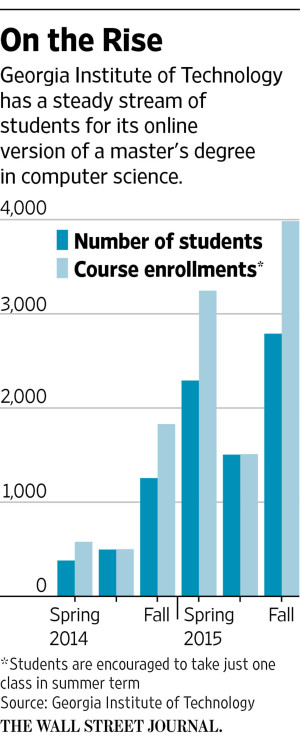Melissa Korn wrote an article yesterday in the Wall Street Journal giving a progress report on that Georgia Tech / Udacity MOOC degree (the master’s in computer science).
The Georgia Tech online computer-science program is relatively massive: It has 2,789 students enrolled this semester, compared with 312 in the campus-based version. It’s on track to turn a profit by May, according to Charles Isbell Jr., senior associate dean at the College of Computing. It has a steady stream of more than 1,300 applicants for each new term. [snip]
At Georgia Tech, Mr. Isbell is still thinking on a grand scale: “It wouldn’t surprise me if three years from now we’re talking about 10,000 students instead of 3,000 students,” he said. “This is sustainable and this is scalable.”
The article takes a generally positive tone describing the program, although it does call out that students are taking just 1.4 courses per term, “below the school’s initial projection”. In addition:
And the low price point for the online master’s degree—just under $7,000, compared with more than $38,000 for the bricks-and-mortar version—has proven almost too much of a draw. Students who may have just dabbled in a few classes, without seeking to earn credit, are instead signing up for the full-degree program and may be dragging down retention rates.
Projections and Reality
I have long considered this Ga Tech / Udacity program to be one of the few meaningful MOOC-based initiatives with potential to have a meaningful impact on for-credit higher education, so it’s worth comparing this WSJ update with the program projections from 2013. The issue is not just whether they have almost 3,000 students, it’s is also whether the reality is matching original forecasts and taking appropriate lessons from the update.
Ry Rivard, then at Inside Higher Ed, had by far the best reporting on this program. In addition to his initial coverage of the announcement, he also obtained the Georgia Tech / Udacity contract and shared it in this article. Some key projections and assumptions from the contract:
- AT&T’s initial sponsorship was planned to be $2 million to cover the first-year startup costs, allowing the program to be self-sustaining (i.e. profitable, with net revenue) starting in year 2 (AY 2014/15). In reality, AT&T ended up sponsoring $3.5 million and the program is “on track to turn a profit by May, according to Charles Isbell Jr., senior associate dean at the College of Computing”.
- The contract assumed degree-seeking students would take 2 courses (6 credits) per term and that other paying students (seeking a certificate) would take 1 course per term. As noted in the WSJ, paying students are taking 1.4 courses per term, although the article does not break out degree-seeking and certificate-seeking categories.
- For Fall 2015, the contract assumed 4,787 degree-seeking students and 1,500 certificate-seeking students (total of 6,287). As noted in the WSJ, they current have 2,789 paying students, 56% fewer than planned.
- The contract assumed drop-out rates of a combined ~15% per cohort. As noted in the WSJ, 273 of the original 380 students have graduated or are still enrolled, indicating a drop-out rate of 28% for this cohort.
Despite missing most enrollment and revenue projections, I still consider this program to be important and worthy of analysis. Whether or not Georgia Tech gets to 10,000 students, it does appear they have significantly expanded their reach in computer science by offering remote students a dramatically cheaper master’s degree in computer science.

[…] Melissa Korn wrote an article yesterday in the Wall Street Journal giving a progress report on that Georgia Tech / Udacity MOOC degree (the master’s in computer science). (…) The article takes a generally positive tone describing the program, although it does call out that students are taking just 1.4 courses per term, “below the school’s initial projection”. In addition: …http://www.scoop.it/t/easy-mooc […]